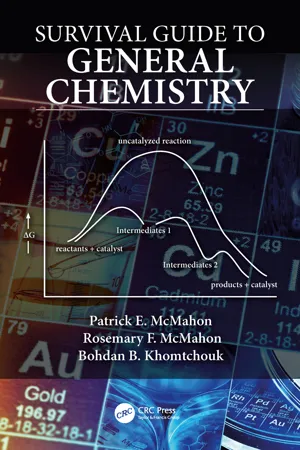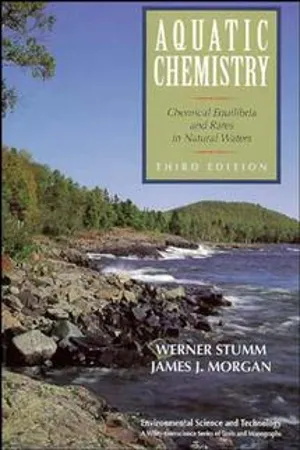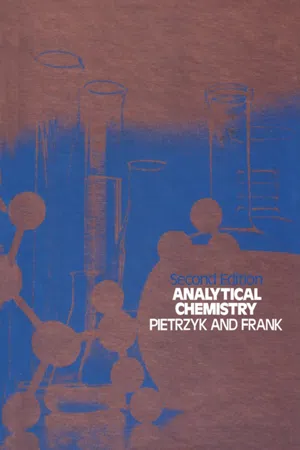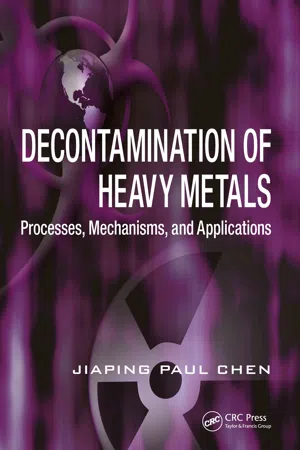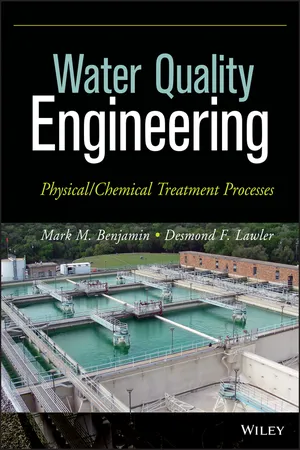Chemistry
Precipitation Reaction
A precipitation reaction is a chemical reaction in which two soluble ionic compounds in a solution combine to form an insoluble solid compound, known as a precipitate. This occurs when the cations and anions of the two compounds combine in such a way that the resulting compound is insoluble and falls out of solution as a solid.
Written by Perlego with AI-assistance
Related key terms
Related key terms
1 of 4
Related key terms
1 of 3
6 Key excerpts on "Precipitation Reaction"
- eBook - ePub
- Patrick E. McMahon, Rosemary McMahon, Bohdan Khomtchouk(Authors)
- 2019(Publication Date)
- CRC Press(Publisher)
9 Precipitation and Acid/Base Aqueous Reactions Concepts and Methods to Design Complete Balanced EquationsI GENERAL CONCEPTS The description of a reaction as precipitation or acid/base involves explaining how electron exchange or sharing alters during conversion of reactants to products, that is, how ionic or covalent bonds are changed during a reaction. Precipitation Reactions and most acid/base reactions occur in solution with water as the solvent; these are termed aqueous solutions.Precipitation Reaction: An exchange of ions and ionic bonding in an aqueous solution to produce new ionic compounds such that one of the new compounds is no longer soluble in water.Acid/base reaction: Process by which an H atom usually in the form of an H+(aq) ion (i.e., in water) is transferred between two compounds.II SOLUBILITY EQUATIONS AND AQUEOUS SOLUTION FORMATS Compounds dissolve at least to some measurable amount in a particular solvent due to attractive forces between the compound being dissolved (solute) and the compound doing the dissolving (solvent). These attractive forces are termed intermolecular (see Chapter 21 ) and ion-dipole forces and are combined with the entropy of solvation.For water as a solvent, the form of a compound in aqueous solution affects the reaction and the method of writing an equation. Ionic and covalent compounds generally behave differently when dissolved in water.Covalent compounds often contain polar covalent bonds; if they dissolve in water this is due to attractive forces between the polar ends of the neutral covalent molecule and the polar ends of water molecules. Most solution applicable covalent compounds come in the form of molecules; solution from bulk matter occurs by separation of individual molecules, surrounded by water molecules, into the water solvent.Covalent compounds generally remain as neutral intact molecules - eBook - ePub
Aquatic Chemistry
Chemical Equilibria and Rates in Natural Waters
- Werner Stumm, James J. Morgan(Authors)
- 2012(Publication Date)
- Wiley(Publisher)
CHAPTER 7
PRECIPITATION AND DISSOLUTION
7.1 INTRODUCTION
The hydrological cycle interacts with the cycle of rocks. Minerals dissolve in or react with the water. Under different physicochemical conditions, minerals are precipitated and accumulate on the ocean floor and in the sediments of rivers and lakes. Dissolution and Precipitation Reactions impart to the water constituents that modify its chemical properties. Natural waters vary in chemical composition; consideration of solubility relations aids in the understanding of these variations. This chapter sets forth principles concerning reactions between solids and water. Here again the most common basis is a consideration of the equilibrium relations.Dissolution or Precipitation Reactions are generally slower than reactions among dissolved species, but it is quite difficult to generalize about rates of precipitation and dissolution. There is a lack of data concerning many geochemically important solid–solution reactions; kinetic factors will be discussed later (Chapter 13). Frequently, the solid phase formed incipiently is metastable with respect to a thermodynamically stable solid phase. Examples are provided by the occurrence under certain conditions of aragonite instead of stable calcite or by the quartz oversaturation of most natural waters. This oversaturation occurs because the rate of attainment of equilibrium between silicic acid and quartz is extremely slow.The solubilities of many inorganic salts increase with temperature, but a number of compounds of interest in natural waters (CaCO3 , CaSO4 ) decrease in solubility with an increase in temperature. Pressure dependence of solubility is slight but must be considered for the extreme pressures encountered at ocean depths. For example, the solubility product of CaCO3 will increase with increased pressure (by approximately 0.2 logarithmic units for a pressure of 200 atm).† - eBook - ePub
- Donald L. Sparks(Author)
- 2018(Publication Date)
- CRC Press(Publisher)
PRECIPITATION Solid phases in soil systems represent a selective accumulation of at least two or more constituent ions into an organized solid matrix which is often crystalline in nature. The process by which this selective accumulation occurs to form a distinct solid phase is termed precipitation. A precipitate can be considered a particulate phase which separates from a continuous medium. 86 The fact that solid phases form in soil systems means that the overall free energy of formation is negative for the combined physical processes operating during the period of the formation. The actual steps leading to the formation of a separate solid phase, however, must occur at the microscale level: the joining together of the constituent ions or molecules that will eventually be recognized as a distinct separate phase. Under classical nucleation theory, three steps are generally considered necessary for these microscale processes to result in the formation of crystals that will persist and survive over relatively long periods of time. 1 A simplified scheme for the sequence of these three steps, as they apply to most solid systems, is shown in Figure 8. Figure 8 Step diagram for processes involved with homogeneous or heterogeneous precipitation from a supersaturated solution. (Modified from Stumm. 1) Step 1 refers to the collisions that occur between constituent ions of the solid phase to be formed due to their thermal motion in solution. A certain percentage of these collisions will result in the formation of critical clusters which in turn form a population of nuclei. A nucleus in which the number of ions reaches a critical number is known as a critical nucleus. 87 The remaining nuclei which do not contain a critical number of ions are termed subnuclei or embryos and redissolve, while the population of critical nuclei continues to grow to form crystallites (step 2) - eBook - ePub
- Clyde Frank(Author)
- 2012(Publication Date)
- Academic Press(Publisher)
Chapter SevenPrecipitation Methods
Publisher Summary
The process of precipitation is a useful separation techniquewhere the main goal is differences in solubility. Groups of metal ions are precipitated, filtered, and separated. A classical example of this is the separation of metal ions into simple groups according to the “hydrogen sulphide” separation scheme. The main goal in precipitation is purification. This chapter discusses experimental steps that are designed to yield a precipitate of the highest purity. These steps do not provide the optimum conditions for complete precipitation. Because of the similarity between the techniques of gravimetry and separation by precipitation, it is not necessary to treat each individually. The chapter also describes the several characteristics of precipitates that are important in separations and gravimetry. Precipitation from a supersaturated condition occurs when a precipitating and sample solution are combined. Even if rapid stirring is coupled with slow addition of very dilute solutions, the formation of irregular crystals and coprecipitation are not eliminated.INTRODUCTION
The process of precipitation has a long history as a useful separation technique. In this technique, differences in solubility are the main goal. Thus, Ag(I) can be separated from a Ag(I)–Fe(III) mixture by the addition of an acidified chloride solution. A precipitate of AgCl is formed, while the Fe(III) remains in solution. Filtering of the solution completes the separation process.Not all Precipitation Reactions are quantitative. For example, Pb(II) can be precipitated as PbCl2 . However, depending on the amount of Pb(II) originally present and the volume of solution, not all the Pb(II) is precipitated. Also, if the temperature is increased, the solubility of PbCl2 is sharply increased. In fact, Ag(I) and Pb(II) can be separated by the addition of chloride ion at elevated temperature. The AgCl precipitate is filtered and after cooling the solution, the PbCl2 - eBook - ePub
Decontamination of Heavy Metals
Processes, Mechanisms, and Applications
- Jiaping Paul Chen(Author)
- 2012(Publication Date)
- CRC Press(Publisher)
3Precipitation Technology
3.1IntroductionPrecipitation is the process by which dissolved metals are made insoluble, usually as metal hydroxides, metal sulfide, and metal carbonate. It is the formation of a solid in a solution or inside another solid during a chemical reaction or by diffusion in a solid. When the reaction occurs in a liquid, the solid formed is called the precipitate , and the liquid remaining above the solid is called the supernatant . The solids or powders derived from precipitation are also known as flowers . The conventional metal removal process is often divided into three steps: (1) pretreatment, (2) precipitation, and (3) posttreatment.Precipitation is the most conventional technology used for production of inorganic materials (e.g., hydrometallurgy) or removal/recovery of toxic (and precious) wastes (e.g., heavy metals). It has been widely used in the treatment of waste streams from industries such as metal mining, metal production, and semiconductor industry.Over 75% of metal treatment operations employ this technology. There are several precipitation treatment reagents available for metal treatment. Among them, hydroxide precipitation is the standard method of removing heavy metals from wastewater. This may be achieved by increasing the pH of metal-containing wastewater with an alkaline reagent to reduce the concentration of the dissolved metals and removing the resultant metal hydroxide precipitates by sedimentation and dewatering operations.Precipitation is suitable for the treatment of various heavy metal ions from wastewater. However, it creates a large amount of metal precipitates, which require further treatment and disposal. This would result in both high capital cost and operation cost. An alternative measure called precipitation–crystallization has been developed. It can overcome the major problems of the traditional precipitation technology. The technology will be presented in Chapter 4 - eBook - ePub
Water Quality Engineering
Physical / Chemical Treatment Processes
- Mark M. Benjamin, Desmond F. Lawler(Authors)
- 2013(Publication Date)
- Wiley(Publisher)
2(9-33)where A is a constant that depends on the size of the unit cell in the solid, is the free energy required to form a particle of the critical diameter from the solutes, for the given SS, and k B is the Boltzmann constant. Substituting Equation 9-32 into the above expression yields(9-34)For sparingly soluble salts, theoretical estimates of the pre-exponential factor in the rate expression are in the range 1025 < A < 1030 nuclei/cm3 s (Randolph and Larson, 1988). However, experimentally determined values can be many orders of magnitude smaller.The preceding discussion characterizes homogeneous precipitation, whereas most Precipitation Reactions in environmental systems are heterogeneous; that is, precipitation occurs on the surface of pre-existing solids. In such cases, the free energy required to initiate formation of a solid is less than in homogeneous precipitation, because, in addition to generating a new interface between the solution and the new precipitate, the process eliminates some of the high-energy interface between the solution and the pre-existing surface. (The new interface that is generated between the two solids typically has a lower surface energy than the solid/solution interface that existed.) This process reduces the activation energy for precipitation and allows spontaneous precipitation to begin once a smaller particle has formed (i.e., it lowers d p,crit ), but it does not change the general shape or qualitative interpretation of the versus d p
Index pages curate the most relevant extracts from our library of academic textbooks. They’ve been created using an in-house natural language model (NLM), each adding context and meaning to key research topics.
Explore more topic indexes
Explore more topic indexes
1 of 6
Explore more topic indexes
1 of 4
